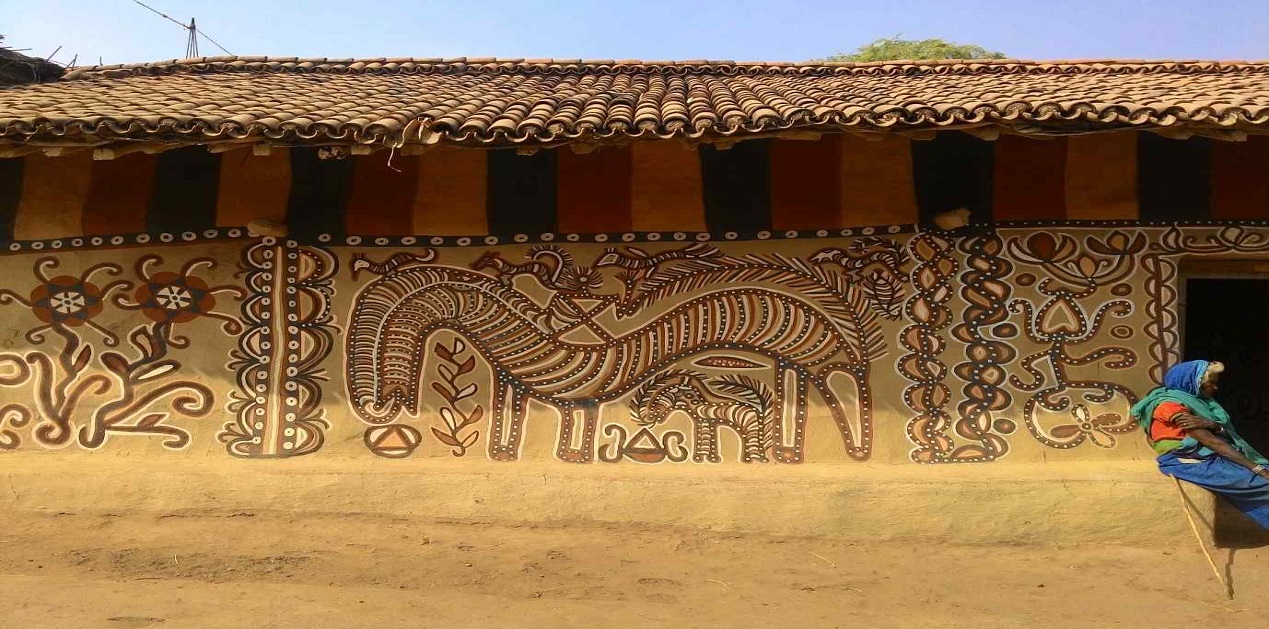The Sohrai Paintings, an indigenous mural art found near the Hazaribagh region of Jharkhand, have attracted attention nationally and internationally in recent years. These paintings have beautiful motifs depicting geometric shapes, animals, flowers, plants and other forms related to nature. Lord Shiva is also portrayed as Pashupati, the lord of the animals, in both zoomorphic and anthropomorphic forms. This is a continuous ancient practice in which the tribal/local women paint their mud house using natural colours derived from haematites and clay found in the region. The paintings can be seen beautifying the walls across Birsa Munda Airport, railway stations, flyovers and government buildings in Jharkhand. The Sohrai paintings were also the highlights of the decorations for the G20 meeting held in Ranchi in March 2023.
Traditional Sohrai Practice
Traditionally, Sohrai is a harvest festival celebrated in the Eastern part of India, a day after the festival of Diwali. In this festival the females in the village worship cattle and livestock. The mud houses are cleaned and decorated with Sohrai paintings. Khovar is also a form of this artwork which is used to decorate houses and floors during marriages. The art of Sohrai-Khovar paintings is a matrilineal practice that has passed on through generations from mothers to their daughters. This art form dates back to the Meso-chalcolithic period (9000-5000 BC). The Isko rock shelter excavated in Barkagaon, Hazaribagh area also has rock paintings that are exactly similar to the traditional Sohrai paintings. In April 2023, the Isko rock art site was declared as a national monument by the Archaeological Survey of India.
Bulu Imam: Revivalist of Sohrai Art
Bulu Imam, an environmentalist, an archaeologist and a conservationist, played a very critical role in identification of the Isko site and reported it to the state archaeological authorities in 1991. Following that, he got in touch with locals and found out about the art form. He dedicated his life to the revival and preservation of these paintings, to improve socio-economic conditions of the artisans and popularise them across the globe. In an effort to empower and inspire tribal women to continue painting and make a living from it, Mr. Imam and his son Gustav Imam founded the Tribal Women Artists' Cooperative (TWAC). The TWAC has organised over 50 international exhibitions to promote the art of Sohrai. He also runs a museum and art gallery Sanskriti Centre in Hazaribagh showcasing the chalcolithic rock paintings as well as the artwork of the tribals. The Gandhi Foundation awarded Mr. Imam the International Peace Award in recognition of his humanitarian efforts. For his contributions, he was conferred with Padma Shri in the 2019 by President Ram Nath Kovind.
Efforts to Enhance Livelihood of Artists
The transformation of mud houses into plastered houses was leading to the disappearance of Sohrai. The efforts of a number of activists have helped in saving the Sohrai paintings and in improving the socio-economic conditions of the artists.
Munna Kumar Singh, Commandant of CRPF 22nd Battalion took upon himself the cleaning and beautification of Hazaribagh. Along with cleaning of the lakes in the city, he monitored the district's campaign of Paint My City. This initiative aimed at decorating walls of railways stations with Sohrai. Commandant Singh’s efforts encouraged the local tribal women artists to be a part of the campaign. His involvement helped in providing better livelihood for the artists as well as in the promotion of the Sohrai paintings.
Jayashree Indwar is another name when it comes to the propagation of Sohrai art. Her efforts have set an example of how a traditional art form could become a symbol of women empowerment. Ms. Indwar has organised various exhibitions to promote the Sohrai paintings. Her workshops have trained hundreds of women from different districts of Jharkhand in this art. She and her team have played an important role in the beautification of the capital city Ranchi. She has been honoured by the Ministry of Railways, the Governor and the Tribal Association for her contribution.
Government Initiatives
In his visit to Hazaribagh in 2016, Prime Minister Modi was impressed by the Sohrai paintings across the railway station and got to learn about its origin. He fondly appreciated the artwork in one of the Mann ki Baat episodes. Since then, this art has further gained traction at national and international levels.
Jharkhand has taken the initiative to paint walls of the houses that are built under the Pradhan Mantri Shahri Awas Yojana with the Sohrai paintings. Similarly, the Ministry of Railway had announced that the trains running from Jharkhand would also be painted with Sohrai. While the walls of railway stations have successfully been decorated, the trains are yet to be painted in a similar manner.
In order to protect and preserve this art in its original form, the Sohrai- Khovar paintings received the Geographical Indication status from the Government of India in 2020. GI conveys “an assurance of quality and distinctiveness which is essentially attributable to the fact of its origin in that defined geographical locality, region or country”. GI is also covered under the Trade-Related Aspects of Intellectual Property Rights (TRIPS) Agreement.
Enhanced support in form of government schemes or public-private partnerships to promote the ancient tradition of Sohrai paintings on the global platform could further substantially expand the scope and reach of this beautiful “India-Positive” story.
(The paper is the author’s individual scholastic articulation. The author certifies that the article/paper is original in content, unpublished and it has not been submitted for publication/web upload elsewhere, and that the facts and figures quoted are duly referenced, as needed, and are believed to be correct). (The paper does not necessarily represent the organisational stance... More >>
Image Source: https://maatighar.com/wp-content/uploads/2021/08/7-768x511.jpg











Post new comment